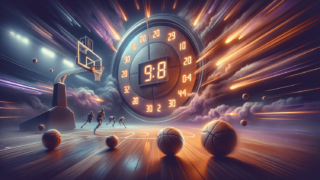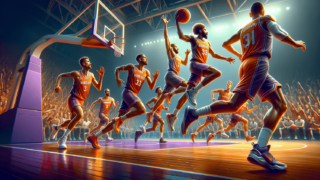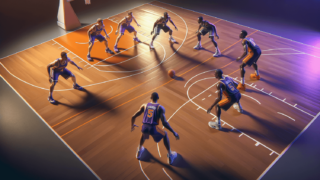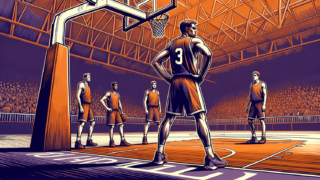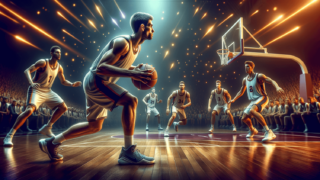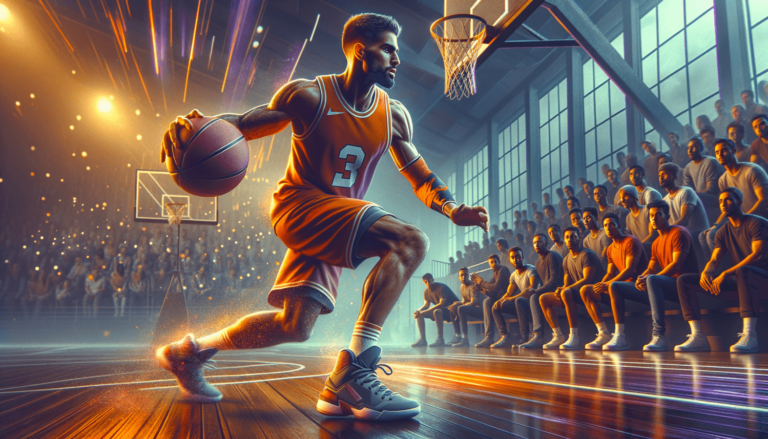
For every aspiring hoopster who dreams of mastering the hardwood, fluid dribbling skills are an essential aspect of your basketball repertoire. But fear not, because we’ve got your back with our latest fun and insightful blog post on ‘How to Get Better at Dribbling in Basketball?’ Whether you’re a beginner looking to develop your fundamental skills, or an experienced baller seeking to refine your dribble moves, this all-encompassing guide will cater to your every need. So lace up those sneakers, grab a ball, and let’s get ready to crossover from average to extraordinary!
How to Get Better at Dribbling in Basketball?
To improve your dribbling skills in basketball, begin by focusing on practicing proper ball control and maintaining a low stance while dribbling. Gradually increase your speed and incorporate different dribbling techniques, such as crossovers, behind-the-back, and between-the-legs moves. Utilize both hands equally and develop strong peripheral vision to better read the court. Consistently practice drills that build fingertip control, reaction time, and overall ball handling skill set. Lastly, watch and learn from elite players to analyze and incorporate their dribbling techniques into your own game.
Master the Basics to Get Started
The first step in becoming a better dribbler in basketball is to ensure you have a solid foundation. Here are some basic techniques that will help you achieve that:
Proper Stance and Posture
When dribbling, maintain a low and slightly crouched stance with knees bent and feet shoulder-width apart. This provides stability and control while making it more difficult for defenders to steal the ball. Keep your head up, eyes forward, and back straight so you can scan the court for potential moves, passes, and shots.
Control the Ball with Your Fingertips
A common mistake when dribbling is using the entire hand or palm to control the ball. Instead, focus on using your fingertips and the pads of your fingers, as this will give you more precise control and better feel for the ball. Spread your fingers wide on the ball to maintain these points of contact.
Low Dribbles
Keep your dribbles as low as possible to reduce the chance of losing control or having the ball stolen. Additionally, a low dribble is more challenging for defenders to reach, making it easier for you to maneuver around them.
Practice Different Dribbling Techniques
Once you’ve mastered the basics, it’s time to incorporate various dribbling techniques into your routine:
Crossovers
Crossovers are an essential technique aimed at quickly changing directions, confusing defenders, and creating space for yourself. To execute a crossover, start dribbling with one hand and quickly bounce the ball to your other hand, switching directions as you do so. Keep the crossover low and fast, which makes it tougher for defenders to anticipate and respond to.
Behind-the-Back
Behind-the-back dribbles are an effective way to maintain forward momentum while protecting the ball from defenders. To perform this move, start dribbling with one hand, then swing the ball behind your back and transfer it to the other hand, continuing your progress down the court. Practice this move frequently, as it requires a good feel for the ball and excellent coordination.
Between-the-Legs
Between-the-legs dribbles are a useful technique for tight situations or when looking to change pace. To execute this move, simply dribble the ball between your legs from one hand to the other, while keeping a low stance and forward momentum. This advanced technique requires precision and substantial practice to achieve consistency and fluidity.
Develop Your Weak Hand
One of the most significant aspects of becoming a better dribbler is developing your off-hand or non-dominant hand. This increases your versatility and unpredictability, making it harder for defenders to anticipate your moves. Start by practicing basic dribbling with your weak hand to develop muscle memory and control. As you progress, incorporate those dribbling techniques learned earlier with your non-dominant hand.
Master Your Peripheral Vision
Good peripheral vision allows you to make better decisions on the basketball court by being more aware of your surroundings. Developing this skill will help you spot open teammates, identify passing lanes, and foresee defensive movements without needing to constantly look around. To enhance peripheral vision, practice dribbling drills while tracking a target, like a partner or object, without looking directly at them. Focus on your surroundings rather than the ball, allowing your muscle memory to guide your dribbling.
Create and Execute Drills
Developing a better dribbling ability requires practice, and specifically targeted drills are essential for honing your skills:
Two-Ball Dribbling
Simultaneously dribble two basketballs to increase your focus, hand-eye coordination, and ball control. Start stationary and then progress to moving up and down the court while maintaining the dribble. This drill will encourage you to develop equal control with both hands, an invaluable skill in basketball.
The Wall Dribble
This simple drill involves standing facing a wall and dribbling the ball against it with your fingertips. Start with your dominant hand, then switch to your weak hand, and finally, alternate between both hands. This exercise reinforces proper finger contact and control of the ball while strengthening the wrist and forearm muscles responsible for good dribbling.
Zig-Zag Drill
The zig-zag drill improves your ability to change directions quickly, simulating real-game situations to help you navigate past defenders. Set up a series of cones in a zig-zag pattern and practice dribbling around them using various techniques – including crossovers, retreat dribbles, and hesitation moves. Focus on maintaining control of the ball while quickly adjusting direction.
Analyze and Learn from Elite Players
Watching basketball games featuring skilled dribblers can provide valuable insight into their techniques, strategies, and styles. Study their moves, how they create space, and how they maintain control in the face of defensive pressure. Consider incorporating moves from these elite players into your practice sessions, tweaking them to match your skills and style.
Consistency and Hard Work
Becoming a better dribbler in basketball takes time, effort, and dedication. Consistently practicing and executing drills while focusing on the essentials like ball control, stance, and peripheral vision is crucial to your development as a player. Embrace the challenge, be persistent in your practice, and you will undoubtedly see significant improvement in your dribbling aptitude.
Maximize Your Fitness and Agility
Improving your overall physical fitness and agility will greatly enhance your ability to handle the basketball. Focus on exercises and training routines that will build your speed, strength, coordination, and endurance:
Cardiovascular Exercise
Running, swimming, or cycling are excellent ways to build cardiovascular endurance and improve your stamina on the court. Regular cardiovascular workouts will help in keeping you active and maintain energy levels when dribbling for extended periods or during high-pressure situations.
Strength Training
Incorporate full-body strength training exercises into your routine, targeting core, legs, and upper body muscles. This will lay a solid foundation for your dribbling abilities, making you more resilient against aggressive defensive pressure and helping you maintain control of the ball with greater ease.
Agility Drills
Agility-focused training, such as ladder drills, shuttle runs, and cone drills, will enhance your coordination, footwork, and ability to change directions quickly. This quick and precise directional change skill will translate directly to your dribbling ability, making it harder for defenders to track and contain you.
Invest Time in Ball Handling Drills
Ball handling skills closely correlate with dribbling success. Spending time on ball handling drills will further refine your touch, coordination, and overall control during the game.
Tennis Ball Toss
Toss a tennis ball or similarly sized object into the air with your non-dribbling hand while maintaining your dribble with the other. Try catching the ball while continuing to dribble. This drill can be done stationary or moving and helps develop hand-eye coordination and focus.
Figure-Eight Drill
Dribble the basketball using both hands in a figure-eight motion around your legs. The focus here is on ball control, dribbling speed, and seamless transfer of the ball between your hands. As your proficiency increases, try adding variations, like dribbling through the legs or using only one hand for the entire movement.
Study Your Court Positioning
Understanding where you are on the court can dramatically improve your dribbling decision-making. Study offensive schemes and positioning to develop a clear awareness of where you should be in relation to teammates and opponents.
Spacing and Angles
Knowing how to effectively create and exploit space can greatly enhance your dribbling success. Develop an understanding of where you should position yourself for optimal spacing and angles within your team’s offensive setup. This knowledge will help you create more opportunities while dribbling and dictate the flow of the game.
Leverage Screens
Effective dribblers know how to utilize screens set by their teammates to shake defenders and create their drives. By recognizing where screens are coming from and how to maneuver around them, you’ll be able to create higher quality offensive opportunities for yourself and your team.
Develop Basketball IQ and Mental Toughness
Improving your dribbling skills also requires enhancing your mental game, as decision-making and adaptability often separate average dribblers from the elite:
Decision-Making Under Pressure
As a ball-handler, you’ll often find yourself confronted with high-pressure situations. Learning how to stay calm and make quick, smart decisions will greatly benefit your dribbling ability. To develop this skill, practice dribbling while under defensive pressure or in simulated game scenarios, gradually increasing the difficulty to simulate real opposition.
Boundless Confidence
Confidence is a crucial factor in successfully dribbling past defenders and making game-changing plays. Believe in yourself and your skills, trusting the hours you’ve invested in practice. When you step onto the court, visualize success and challenge yourself to take calculated risks during the game.
Ability to Learn from Mistakes
Regardless of skill level, mistakes and turnovers are inevitable in basketball. The key is learning from them and understanding why they occurred. Analyze your gameplay, identify areas that require improvement, and implement adjustments to grow as a player.
By incorporating these additional guidelines into your practice routine and gameplay, you’ll be on a path to achieving significant improvement in your dribbling abilities.
FAQ Section: Dribbling in Basketball
Here is a collection of frequently asked questions and concise answers tailored to address common topics related to improving dribbling skills in basketball. These questions and answers will help further clarify essential aspects of the game and provide guidance as you work on mastering the art of dribbling.
1. How important is dribbling in basketball?
Dribbling is a fundamental skill in basketball, essential for ball-handling, maneuvering on the court, and creating scoring opportunities for both yourself and your teammates. Strong dribbling ability allows players to control the tempo of the game and adapt to various situations on the court.
2. How do I practice dribbling on my own?
To practice dribbling on your own, focus on executing drills that enhance your ball control, speed, and use of both hands. Incorporate activities like the two-ball dribble, wall dribble, and zig-zag drills into your routine while constantly challenging yourself to improve in each session.
3. How do I protect the ball while dribbling?
Protect the ball while dribbling by maintaining a low stance, keeping the ball low, and using your body and non-dribbling arm to shield the ball from defenders. Reading the defender’s positioning and executing strategic dribble moves such as crossovers will also help protect the ball.
4. How can I improve dribbling speed?
To improve your dribbling speed, work on strength training (particularly upper body and forearm strength) and consistently practice dribbling drills with an emphasis on increasing speed. Gradually push yourself to dribble at faster rates while maintaining control of the ball.
5. How do I make my dribble moves more unpredictable?
To make your dribble moves more unpredictable, focus on mastering various dribbling techniques and expanding your skill set. Develop your off-hand, change pace and direction abruptly, and study elite players to incorporate new moves into your game.
6. Can I become a better dribbler without playing in games?
While participating in games is beneficial, you can still improve your dribbling through diligent practice, targeted drills, and analyzing gameplay of skilled dribblers. Consistently practicing dribbling skills and creating game-like situations will help enhance your dribbling ability without needing actual game experience.
7. What should I focus on while practicing dribbling?
When practicing dribbling, direct your focus on proper ball control, maintaining a low stance, peripheral vision, and incorporating diverse dribbling techniques. Additionally, work on developing your off-hand and mental aspects of the game, such as decision-making and confidence.
8. How do I improve my ball-handling skills to complement my dribbling?
Improve your ball-handling skills by dedicating time to exercises like the figure-eight drill, tennis ball toss, and other drills that focus on finger control and hand-eye coordination. As your ball-handling improves, your overall dribbling ability will naturally follow suit.
9. How can I improve my dribbling under defensive pressure?
To improve dribbling under defensive pressure, train alongside a partner who simulates defensive pressure or use agility tools like resistance bands while dribbling. Focus on maintaining control and decision-making during such exercises to better prepare for real-game situations.
10. How long does it take to become a better dribbler?
The timeline for becoming a better dribbler varies for each individual, depending on factors such as starting skill level, dedication to practice, and inherent athletic abilities. However, consistent practice, emphasis on fundamentals, and willingness to learn from mistakes will expedite your improvement.
Featured Posts
- No pillar pages found.
